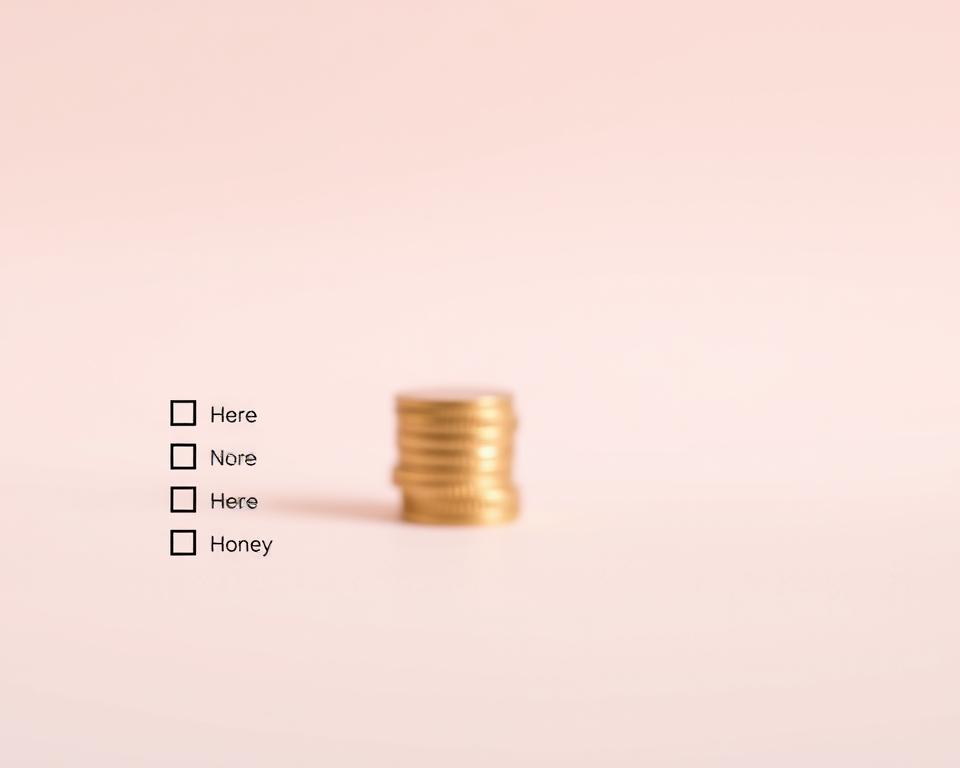Anuncios
Have you ever wondered why people save money even when it feels hard to start? This question nudges at a deeper truth: your choices around cash are often driven by emotion, not spreadsheets. Understanding that link helps turn good intentions into steady action.
Saving money delivers clear perks you can feel today. It brings seguridad, more freedom at work, and a cushion for surprises. Bankrate found that many Americans lack even a small emergency fund, which makes building savings urgent.

When you tie your goals to real feelings — control, calm, and options — you stick with the plan. The main reasons to start now are simple: avoid steep emergency costs, fund trips or education, and gain choices that improve your daily life.
As your balance grows, so does your confidence. That gentle progress makes future decisions easier and gives you breathing room to pursue what matters most.
What the psychology of saving means for you right now
Setting aside a little each month rewires your habits and eases daily strain. Consistent action reduces stress and gives you clearer options in the present.
Control, certainty, and your brain’s need for a safety margin
Your brain prefers predictability. A small buffer creates a safety margin that calms anxiety and makes checking your account less stressful.
Set aside modest amounts first. Even with the same ingreso, two people can end up in very different places based on routine and framing.
How emotions drive your saving habits more than math
Emotions steer most financial choices. Tie your objetivos to feelings—prepared, free, or calm—to stay consistent over tiempo.
Rituals beat willpower. Automate transfers, break big goals into milestones, and note your top reasons to keep the process meaningful.
- Automate small transfers for steady ahorros.
- Write your top three objetivos and review weekly.
- Use milestones for frequent wins and clearer feedback.
- Build a five-minute weekly check-in as a simple ritual.
- Notice how a safety margin changes daily choices.
For more on the psychological patterns behind these steps, read this short piece on the psychology of savings.
Why people save money
Small cushions of cash change how you respond to a sudden bill or an awkward job shift. That cushion lowers stress and gives you choices instead of panic.
Peace of mind and reduced financial stress
Having a plan calms your daily outlook. Regular savings reduce anxiety because common expenses no longer feel like emergencies.
Planned funds for a vacation or repairs keep you from using high-interest credit. That stability improves sleep and focus.
Autonomy, work flexibility, and career runway
With a buffer, you can consider a sabbatical, switch jobs, or start a side project without immediate pressure.
Savings create runway—time to upskill, negotiate from strength, or pursue goals that match your values.
Security for your family and future self
Putting cash aside protects your family when life shifts and supports long-term goals like retirement or a home.
When your savings reflect priorities—family, experiences, and stability—you’ll stay motivated to keep contributing.
- You set aside funds so unexpected expenses don’t derail your week.
- Buffers let you be patient with opportunities and take smarter risks.
- Consistent saving funds vacations, retirement, and a future home without guilt.
Your emergency fund: the cornerstone of financial resilience
A dedicated cushion of cash keeps short-term crises from becoming lasting setbacks. Start with a clear target and an easy plan to build that cushion over months.
How much to set aside to cover living expenses
Experts typically recommend three to six months of living expenses. For context, BLS data implies six months for the average household could be around $36,000.
Bankrate found 56% of Americans couldn’t cover a $1,000+ emergency from savings. Use that reality to motivate a practical goal.
What counts as an emergency and what doesn’t
True emergencies include sudden unemployment, medical bills, and urgent home repairs. Planned costs like routine gifts or normal taxes are not emergencies.
Realistic ways to start saving months of expenses
- Keep one month’s amount in a separate savings account labeled “Emergency Fund.”
- Automate a small transfer each month so the fund grows without extra effort.
- After an emergency, restart transfers immediately to rebuild the cushion.
“A small, dedicated fund turns unexpected costs into manageable events.”
As an example, if your monthly expenses are about $3,000, aim for $9,000 as a first milestone. For more detailed emergency fund guidance, follow that link to practical steps and templates.
Retirement and time: using compound interest to your advantage
A modest monthly deposit can turn into a substantial retirement nest egg with enough years and a steady rate. Time is the single most powerful lever when you plan for retirement. Early contributions let interest build on interest so each dollar works harder over the long haul.

Why starting early beats larger amounts later
Starting now trumps trying to catch up later. An example: $100 per month at a 6.5% annual rate becomes about $16,195 in 10 years, $46,594 in 20 years, and $103,656 in 30 years.
That extra time magnifies growth and lowers the pressure on your income and career choices.
401(k), Roth 401(k), and IRA basics
Use tax-advantaged accounts to boost long-term savings. Traditional 401(k) contributions reduce taxable income now. Roth 401(k) and Roth IRAs grow tax-free for qualified withdrawals later.
Employer match, contribution limits, and tax benefits
- Capture the match: Contribute at least enough to get any employer match—it’s free compensation.
- 2024 limits: You can put up to $23,000 into a 401(k), or $30,500 if you are 50+.
- Consejo: As your income rises, bump contributions by 1% annually to increase savings without feeling the hit.
“Time, consistent deposits, and the right accounts turn small habits into sizable retirement balances.”
Funding life goals: home, education, and big milestones
A clear plan helps you turn major goals into manageable steps. Start by picking a target payment and a timeline. Then choose where to keep that fund so it grows but stays accessible when you need it.
Down payment strategies to lower your mortgage rate and avoid PMI
Aiming for a 20% down payment often avoids PMI and may secure better interest rates. If that full payment isn’t feasible, look into VA, FHA, or USDA loan options that allow lower or no down payments while you keep building savings.
Keep your down payment in a conservative savings account—or a CD or money market—so the funds are safe when you find the right house.
Saving for education with tax-advantaged accounts
For education costs, consider a 529 plan so your savings grow tax-free and may offer state tax benefits. Use separate accounts for each goal so progress is clear and motivation stays high.
- Estimate the target amount: 20% plus closing costs and expected early repairs.
- Decide monthly allocations and automate transfers on payday.
- Revisit targets quarterly as prices and priorities change.
“Split goals into specific accounts and fund them automatically to build steady progress.”
Travel, experiences, and the joy of planned spending
A simple monthly transfer can turn dream trips into paid-in-full arrivals, not lingering bills.
Build a dedicated vacation fund so you book with confidence and avoid high-interest debt. Decide on a realistic amount each month and automate deposits into a separate account.
Book flights and hotels with a credit card for rewards, then pay the statement in full from your cash fund. This earns perks without the interest that creates long-term debt.
- Create one fund and split it into categories: flights, lodging, activities.
- Set a monthly target, automate transfers, and price out costs early to firm your timeline.
- Include a small buffer for surprises and pause contributions only for true emergencies—restart as soon as you can.
- After your trip, review spending and adjust your plan so the next vacation fits your goals.
“Planned travel proves you can save money for joy with intention—memories last longer when debt doesn’t follow you home.”
Where to keep your savings so your cash works harder
Where you hold your cash changes how fast it grows and how quickly you can use it. Choose the right mix of accounts to match each goal: emergency, short-term, and planned expenses.
High-yield savings accounts versus standard savings
High-yield savings account options usually offer a better rate than a standard savings account.
Use a high-yield option for short-term funds you may need soon. It keeps cash liquid while earning more interest.
Standard savings accounts work for very small balances, but compare yields so you don’t leave returns on the table.
Certificates of deposit and money market accounts
Certificates of deposit (CDs) lock funds for a set term and often pay higher rates. Laddering CDs balances access and earnings.
Money market accounts can offer competitive yields plus limited check-writing. They suit larger short-term balances that might need occasional access.
FDIC/NCUA insurance and why safety matters
Safety matters for emergency cash. U.S. deposit insurance protects deposits up to $250,000 per depositor at an FDIC-insured bank or NCUA-insured credit union.
Keep your emergency cash highly liquid. For near-term goals, favor accessibility and protection over chasing the absolute highest yield.
- Segment accounts by purpose: emergency, short-term goals, taxes.
- Review rates periodically and move funds if a better option appears.
- Avoid risky products for money you’ll need soon; align each vehicle to your timeline.
“The right mix of savings accounts, money market accounts, and CDs helps your cash work harder while keeping it safe.”
Design your saving system: habits that stick
Set up a simple system that moves cash out of your checking before you can spend it. This removes temptation and makes progress automatic.

Pay yourself first with automatic transfers
Automate transfers on payday so you treat saving like a bill you always pay. Schedule a small transfer each pay period; consistency beats large, irregular deposits.
Automating also protects your checking balance. When transfers happen first, the rest of your income becomes the working amount for bills and fun.
Use sinking funds for irregular expenses
Create named sub-accounts for taxes, gifts, car repairs, and home projects. A sinking fund keeps these predictable but irregular costs from raiding your emergency savings.
- Keep separate accounts or labeled sub-accounts so each goal has its own home.
- Review your budget monthly and adjust contributions as your income changes.
- Automate a small annual increase so your savings grow with pay raises.
“Small, consistent transfers make long-term progress feel easy and reliable.”
From saving to stability: minimizing debt and stress
A well-stocked emergency reserve keeps urgent costs from turning into long-term obligations. Build a starter fund so you can meet sudden bills without reaching for high-rate credit.
When you have cash on hand, you act from choice, not panic. That reduces stress and preserves your credit standing when an unexpected expense arrives.
Avoiding credit card dependence during emergencies
With a funded emergency reserve, you avoid leaning on a credit card in a crisis. This prevents interest from compounding and keeps existing debt from ballooning.
- Pay urgent bills in cash so balances don’t turn into long-term debt.
- Keep emergency funds separate so you don’t spend them on wants.
- After a withdrawal, replenish the fund to restore your safety net.
If you carry balances, automate minimums and direct extra dollars to the highest-rate accounts after you hold a small reserve. As your income rises, increase contributions to both savings and payoff.
“A small, dedicated cushion lets you cover living costs while you regroup — and that lower stress is one of the top reasons to build a fund.”
The psychological benefits you feel as your balance grows
Seeing steady growth in your accounts shifts your mindset from reaction to planning. That shift gives you a clearer sense of control and reduces daily decision fatigue.
You’ll respond more calmly to surprise bills because you trust the system you built. Small, predictable wins make unexpected costs feel manageable rather than overwhelming.
A larger balance creates real options: taking extra time off, investing in a course, or changing your career path with intention. Your family gains stability too—fewer arguments and more confident planning.
Progress feeds motivation. As you watch your savings rise, you say no to impulse buys more easily and focus on long-term goals. That confidence spills into other areas: you negotiate better and plan further ahead.
“A steady habit and visible results turn short-term sacrifices into long-term gains.”
- More control lowers stress and improves daily focus.
- Calmer reactions replace knee-jerk spending during surprises.
- Clearer priorities help you protect the life you’re building.
How to start saving today: a simple, step-by-step plan
A brief audit of your spending reveals where small shifts free up extra cash each month. Start by listing fixed bills, subscriptions, and variable purchases. This gives you a clear budget and shows where to trim without pain.
Audit expenses and set clear goals by time horizon
Name goals as now, soon, and later. Pick an amount and a target month for each. Use an example target—$1,200 in 12 months—to build a quick win and learn the habit.
Open the right accounts and pick a saving rate
Open a high-yield savings account for short-term goals and an everyday savings account for small buffers. Keep retirement in tax-advantaged accounts like a 401(k) or IRA and consider a 529 for education.
Track progress and adjust as income and goals evolve
Automate a starter transfer each pay period, then raise it as your income grows or bills fall. Fund an emergency fund first, then split extra cash across goals like a car, travel, or education.
- Automate transfers so you pay yourself first.
- Use separate labeled accounts or sub-accounts to see progress.
- Check weekly or monthly and tweak amounts as life changes.
“Small, consistent steps make long-term savings feel simple and real.”
Conclusión
Start small, then build momentum with one automatic transfer each month. Starting with a modest amount helps you start saving without stress and keeps your budget intact.
Choose the right savings account or account mix so each dollar earns a little more. A high-yield option and clear goals—emergency cushion, retirement, and a payment house target—work together to protect your family and future.
Aim for a stronger payment for a house to lower PMI risk and get a better rate. Adjust contributions as your income rises, track the amount each month, and remember the main reasons save money: control, options, and peace.
Preguntas frecuentes
What drives your desire to build a financial cushion?
You gain control and certainty when you keep a cash buffer. Your brain treats savings as a safety margin that reduces stress and helps you make clearer choices. That calm makes it easier to handle job changes, unexpected car repairs, or short-term income dips without relying on credit cards.
How much should you set aside for an emergency fund to cover living expenses?
Aim for three to six months of essential costs if you have steady work; consider six to twelve months if your income is variable or you support a family. Start with a smaller, reachable target—like $500 to $1,000—then build up using automated transfers into a separate savings account.
What counts as an emergency versus a regular expense?
Emergencies are unplanned, necessary costs that preserve income or well‑being—medical bills, urgent home or car repairs, or sudden job loss. Routine bills, planned vacations, or elective upgrades don’t qualify and are better funded through sinking funds or dedicated accounts.
How do emotions influence saving habits more than math?
You’ll often act based on fear, security, pride, or immediate gratification rather than long‑term calculations. That’s why framing matters: automate deposits and name accounts (vacation, repairs, retirement) to tie feelings to goals and reduce impulse spending.
Why does starting early for retirement outperform larger contributions later?
Compound interest rewards time. Even modest automatic contributions to a 401(k), Roth 401(k), or IRA grow significantly if you begin in your 20s or 30s. Delaying means you must save much more later to reach the same balance.
What role does an employer match play in retirement saving?
An employer match is essentially free money. Prioritize contributing at least enough to capture the full match before investing elsewhere. It accelerates growth and improves your long‑term return without extra effort.
How should you save for a down payment to lower mortgage costs and avoid PMI?
Target at least 20% of the home price to avoid private mortgage insurance (PMI) and secure better rates. Use a mix of high‑yield savings or short‑term CDs for funds you’ll use within a few years, and keep the money liquid and insured.
What are efficient ways to save for education with tax advantages?
Consider 529 plans for college savings; they offer tax‑free growth and flexible beneficiary rules. For K‑12 or other qualified expenses, check your state’s plan details. Coverdell ESAs and custodial accounts are alternatives with different rules and limits.
How can you fund travel without relying on high‑interest credit cards?
Create a dedicated vacation fund and make monthly transfers into it. Use a high‑yield savings account to keep the balance accessible and earn interest while you plan. Avoid impulse charges and book with cash where possible to prevent debt buildup.
Where should you keep savings so cash works harder without risking access?
Use high‑yield savings accounts for your emergency fund and short‑term goals. For slightly longer horizons, consider CDs or money market accounts to capture higher rates. Always verify FDIC or NCUA insurance and keep emergency funds liquid.
How do you design a system of habits that actually sticks?
Pay yourself first by automating transfers the day you get paid. Break big goals into sinking funds with specific targets and timelines. Review and adjust your saving rate every few months as income or priorities change.
What are sinking funds and how do they help with irregular expenses?
Sinking funds are separate accounts you fund regularly for planned but infrequent costs—car maintenance, holiday gifts, or insurance premiums. They prevent large hits to your budget and reduce reliance on credit when expenses arrive.
How can you minimize debt and credit card dependence during emergencies?
Keep an emergency fund that covers several months of essential expenses. If you must use a credit card, pay the balance quickly to avoid interest. Consider a low‑interest personal line of credit as a backup, but prioritize rebuilding cash reserves afterward.
What psychological benefits will you notice as your balance grows?
You’ll feel increased confidence, reduced anxiety about unexpected costs, and more freedom to make career or life choices. Those emotional gains reinforce good habits, making it easier to maintain and grow your funds over time.
How do you start saving today with a clear, step‑by‑step plan?
Audit your monthly expenses, set specific goals by time horizon, and choose account types that match each purpose. Open a high‑yield savings account for emergencies, set automatic transfers to pay yourself first, and track progress monthly to stay on course.



